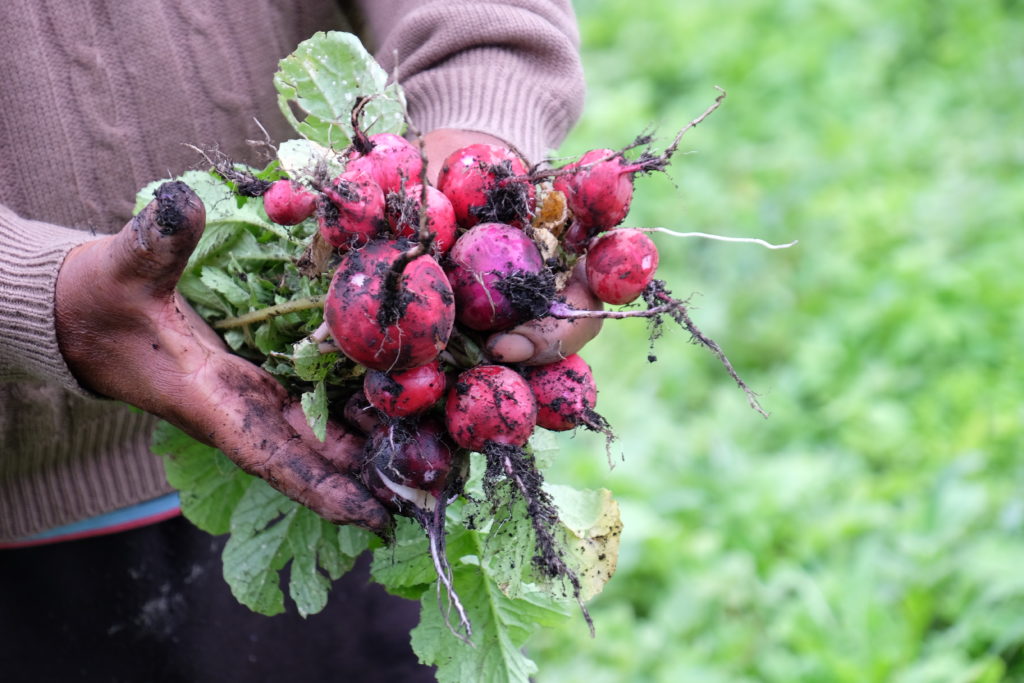

Instructor: Naomi Tomky
Dates: ON HIATUS
Duration: 6 Weeks
Level: Any
Price: $420, scholarships available
Whether you’ve only ever kept your own blog or you’re already earning money from your food writing, this six-week class is designed to take you to the next level. Using weekly lessons, interactive tools, and personal feedback, students will learn about and then put into practice the elements of creating and selling great stories about food, wine, spirits and other beverages.
Instructor Naomi Tomky has written about food for Saveur, Food & Wine, and The New York Times. She was included in the 2017 Best Food Writing and was a recipient of a 2019 Lowell Thomas and the Association of Food Journalism’s Best Food and Travel Writing Award. In this class, she uses her own experience and expertise, as well as writing by her peers and idols to demonstrate the best ways to use words to express thoughts and feelings about food.
Readings, writing prompts, and exercises will keep students inspired throughout the class, whether their goal is to begin writing for publication, moving from amateur to professional, or to explore better ways to pitch editors and make more money.
Each week, the class will cover one element of food writing and one element of the business of writing about cuisine, foodway, wine, spirits and beverages. Students will leave with assigned activities and readings each week, and instructor Naomi Tomky will provide personal feedback on each assignment.
Recently, Focus on Food Writing has helped students break into outlets including BBC Travel, Bon Appétit, Condè Nast Traveler, The Counter, Fodor’s, The Kitchn, Modern Farmer, The Nosher, The Philadelphia Inquirer, Self, Shondaland, The Washington Post and Zagat. Let Naomi help elevate your publication game too!
Please note: this course doesn’t workshop pieces about dieting or disordered eating, in order to keep the classroom a safe space for everyone.
 Also, our usual co-teacher Kae Lani Palmisano is on hiatus this term. This “edutainer” is an Emmy-winning television host of WHYY’s Check, Please! Philly, as well as the writer and host of the food history series Delishtory. She is also a food and travel writer, recipe developer, and home cook. Her coverage has appeared in Food & Wine, USA TODAY, The Philadelphia Inquirer, KitchenAid Stories, Roads & Kingdoms, and more.
Also, our usual co-teacher Kae Lani Palmisano is on hiatus this term. This “edutainer” is an Emmy-winning television host of WHYY’s Check, Please! Philly, as well as the writer and host of the food history series Delishtory. She is also a food and travel writer, recipe developer, and home cook. Her coverage has appeared in Food & Wine, USA TODAY, The Philadelphia Inquirer, KitchenAid Stories, Roads & Kingdoms, and more.
FOCUS ON FOOD WRITING CURRICULUM
The class is asynchronous, meaning you never have to be online at a particular time. Naomi’s written lectures post once a week, along with assignments. You then receive critiques from her, as well as feedback from your peers. Students can ask questions and start discussions throughout the course , which also has a final Q&A.
Week 1: In the introduction, we’ll discuss what, exactly, food writing is, and all of the different shapes it takes. We will work on description: how do we describe what we’re eating in a compelling, appetizing way? Or unappetizing, if necessary.
Assignment: Tell Me About Your Lunch
Week 2: Food might be inanimate, but writing about food is an action—and so is growing, eating, and transporting it. This week we’ll discuss using action in our food writing and how that shapes a story. We’ll also focus on the action of identifying a story—and making sure it has a narrative arc.
Assignment: Identifying stories
Week 3: This week, we’ll get into deeper ways to shape our work
using voice and tone to shape. Taking that into the business side, we’ll look at how the work changes in various contexts as we learn about pitching: what it is and where our writing can find a home.
Assignment: Pitch your dream outlet
Week 4: Food is everywhere, but what about it is a story? This week is all about research: where do you find stories (even while stuck inside during a pandemic), how do you learn more about them, who do you interview, what information can you trust?
Assignment: First draft
Week 5: Think about the difference between the first time you cook a dish and the last: that’s what editing does for your writing. Tighten up your sentences, improve your writing, and look for the places where you need to add a garnish sentence. We’ll also talk about how to tighten up your relationships and connections to editors and outlets to ensure continued work.
Assignment: Final draft
Week 6: It’s dessert! In the final week, we’ll focus on a few advanced techniques you’ll need to delve further into food writing: best practices in interviewing, restaurant reviewing, and recipe writing. We’ll also address any outstanding questions from previous weeks, before we move into the final business lesson: how to ask for what you’re worth (and more).e move into the final business lesson: how to ask for what you’re worth (and more).
REVIEWS OF FOCUS ON FOOD WRITING
“This has been a terrific class! Thanks so much, Naomi and Kae Lani — not only have I had a great time over the last six weeks, but I feel you’ve helped me with my food writing. You’re both excellent editors, who point out flaws (with kindness!), while also providing the necessary guidance to craft a better story. Thank you, thank you!” — Jeremy Tarr
“Thank you Naomi and Kae Lani for your help, kindness, and guidance! I appreciated everyone in the class for their comments as well, as I start journeying into food writing. I learned a lot about ways to improve my writing and my pitching, and it helped alleviate some fears.” — Zac Jones-Gómez
“The course was very well structured and the lessons built off one another well. It was very accessible and has provided me a wealth of information, I’ve noticed my writing getting much more effective after the class.”
“This workshop really helped me to clean up and rethink my food writing. I definitely recommend Naomi’s class for anyone interested in culinary writing, whether you’re brand new or well seasoned (all pun intended).”
“Naomi’s class is a wonderful guide to food writing! Lectures cover writing mechanics, industry expectations and pitching guides, and encourage us to develop our own perspectives on food writing. The reading lists and feedback are specific and immensely helpful. Additionally, she sets clear guidelines for the workshop portion of class and ensures class comments are productive and respectful.”
“Focus on Food Writing was the perfect introduction to food writing. I learned about the different types of food writing as well as the writing techniques used in the genre. I also learned how to center storytelling. The weekly feedback I received from the instructor as well as my peers challenged me to think more critically and expansively. I look forward to re-visiting the curriculum as I continue to build my skills and highly recommend this class!”
“I loved each week’s assignment and Naomi’s detailed and thorough feedback. Her comments were wonderful and I learned daily from them. If she did another food writing class with different goals, I would be interested in taking it.”
“Naomi is a wonderful teacher. I learned so much about my writing and habits from her feedback.”
“As an unemployed service worker aspiring to break into food writing, Naomi Tomky’s class was a gift that all writers could benefit from.”
SELECTED WORKS FROM ALUMNI OF FOCUS ON FOOD WRITING
- Farm Profile; Sagging Fence Farm in Local Food by Sally Zalac
- My Secret Ingredient is Always My Playlist in Shondaland by Kurt Suchman
- Los Kentubanos: Digging Into Louisville’s Cuban Side in Condè Nast Traveler by Zac-Jones-Gómez
- Grocery Shopping Used to Be My Self-Care—Now It’s Overwhelming in Self by Colleen Stinchcombe
- This Might Be the Best Airport Meal in America. But Is It Worth $995? In Fodor’s Travel by Jeremy Tarr
- A Short History of Challah Bread, and How It Got So Sweet in America in The Nosher by Liz Susman Karp
- This Bollywood Actor’s Cooking Videos Are Getting Me Through the Lockdown in Self by Rathina Sankari
- The Little Splurge I Made for My Freezer That’s Totally Paid for Itself in The Kitchn by Meleyna Nomura
- The Most Underrated Bakery Near You Is Your Neighbor’s Front Porch in Bon Appétit by Carrie Honaker
- What’s a Food Writer Anyway? My Complicated Feelings with Calling Myself One in 14East by Robin Mosley
- How This Ancient African Religion Keeps Diaspora Foodways Traditions Alive in Fodor’s by Anneliese Wilson
- Vegan barbecue is carving out a place in traditional meat-smoking regions in The Washington Post by Jessica Eng
- Celebrating Indigenous culture with Haudenosaunee boiled cornbread in The San Diego Tribune by Lauren J. Mapp
- An Indigenous Community Reclaims Land in Chile for Organic Agriculture in Modern Farmer by Colleen Stinchcombe
- After a call to boycott Goya, Philly Latino home cooks lean into traditional recipes in The Philadelphia Inquirer by Alisha Miranda
- Hurricane Sandy battered NYC 8 years ago. Since then, how has the city shored up against future superstorms? in The Counter by Carmen Russo
FREQUENTLY ASKED QUESTIONS
Is the course suitable for experienced writers?
The class covers everything from the basics through the nitty-gritty details and includes personalized reviews of each student’s writing. Some of the elements may be a refresher for more experienced students, but overall there will be plenty of information for seasoned veterans as well as rookies.
Can unpublished or emerging writers benefit from this workshop?
Writers don’t need to be published to participate! All we ask is that they have a desire to better their food writing and are enthusiastic about the learning opportunity.
Where are the classes held?
We’ll be working on a browser-based teaching platform. This allows files to be shared easily, without cluttering your inbox, and gives you classroom access from any net-wired terminal, anywhere in the world. But you’ll still have options to push alerts to email, if that appeals.
When does the bell ring?
Never! Go online whenever you please — the classroom is open 24/7 and the lectures are written. But the course does take place within a six-week timeframe.
How much time does it take?
Roughly three to four hours. Each week will include readings, which should take 30 to 60 minutes, and an assignment, which often takes 90 minutes to two hours. Budget an additional 30 minutes for peer feedback.
What sort of success can I expect?
Your writing will improve and you will feel inspired and ready to move on to the next level in food writing, whether that’s getting your first piece published or getting that marquee byline.
What stops other writers from stealing my ideas?
The class is a safe space to share ideas — each of us will be writing on our own topics and abiding by the ethics of journalism, which include not borrowing or stealing other people’s ideas.
What if I have another question?
Email us at info@writelikeahoneybadger.com. (Please note: we supply this address so we can assist students and alumni. We do not accept proposals to improve SEO or app/web-dev proposals. All off-topic emails will be reported as spam.)
